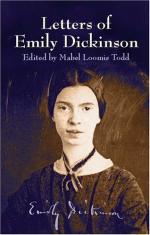|
This section contains 8,586 words (approx. 29 pages at 300 words per page) |

|
SOURCE: "Welcome and Beware: The Reader and Emily Dickinson's Figurative Language," in ESQ, Vol. 34, No. 3, 1988, pp. 181-206.
In the following essay, Oakes argues that Dickinson uses metonymy to develop a "culturally feminine " discursive intimacy with her readers.
"Much Madness is divinest Sense—/ To a discerning Eye," affirms Emily Dickinson: how one "reads" depends on the quality of the reader's lens, the "I." Dickinson muses often, directly and indirectly, about reading. Poetry stuns with "Bolts of Melody"; from "A Word dropped careless on a Page," the reader may "inhale" "Infection," "Despair," "Malaria."1 To Higginson, she insists, "If I read a book [and] it makes my whole body so cold no fire ever can warm me I know that is poetry. If I feel physically as if the top of my head were taken off, I know that is poetry. These are the only way I know it. Is there...
|
This section contains 8,586 words (approx. 29 pages at 300 words per page) |

|


